Embarking on a journey into greenhouse beekeeping unveils a realm where technology meets tradition, optimizing the art and science of apiculture. This comprehensive guide aims to navigate essential facets of greenhouse beekeeping, weaving through its design techniques, equipment necessities, and practical strategies for success.
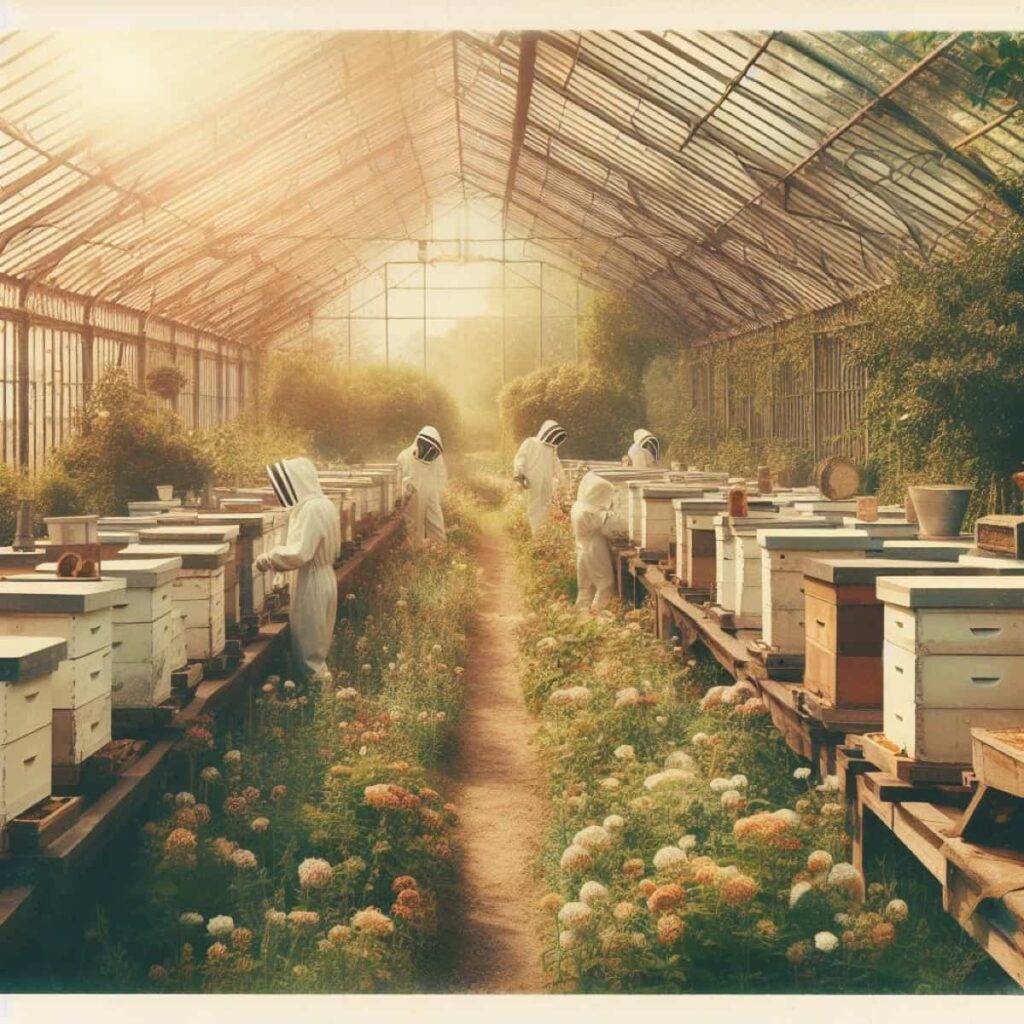
Insights into managing pests and diseases, optimizing honey production, and leveraging modern methods, such as automation and precise environmental controls, illuminate the pathway for beginners and seasoned beekeepers. As we delve into comparisons with traditional beekeeping, legal considerations, and various operational nuances, this guide aspires to be a beacon of knowledge, aiding in navigating the intricacies of greenhouse beekeeping with adept mastery.
Greenhouse Beekeeping Startup Guide
Greenhouse Beekeeping vs Traditional Beekeeping: What’s the Difference?
In the fascinating world of apiculture, greenhouse beekeeping emerges as a modern method that has captured the interest of novice and seasoned beekeepers. This greenhouse beekeeping startup guide will meticulously explore design techniques, advantages, and disadvantages to provide a comprehensive overview. Unlike traditional beekeeping, greenhouse beekeeping allows bees to thrive in a controlled environment, enhancing their productivity and overall health.
Using a beekeeping training manual as a reference, one can adapt various techniques to suit the unique environment of a greenhouse, ensuring that the bee colonies are well-maintained and protected from adverse weather conditions and predators. This system helps bees make more honey and bee stuff by reducing the problems with old-fashioned beekeeping.
How to Choose the Right Greenhouse for Beekeeping
Choosing the right greenhouse is a pivotal decision when stepping into greenhouse beekeeping. Various factors come into play, such as size, materials, ventilation, and insulation. It’s essential to select a spacious greenhouse to accommodate the bee colonies comfortably and allow for their natural behaviors and movements.
Opting for robust and durable materials ensures the structure’s longevity, providing a haven for the bees for an extended period. Adequate ventilation is crucial as it facilitates a flow of fresh air, which is vital for the bees’ survival and well-being. Insulation is another critical aspect, maintaining an optimal temperature within the greenhouse, safeguarding the bees from extreme weather conditions, and promoting a healthy and conducive environment for them to flourish.
Designing a Greenhouse for Bee Colonies: Tips and Considerations
Designing a greenhouse for bee colonies involves a careful and thoughtful approach to creating an environment where the bees can thrive. Referencing a good beekeeping training manual can provide valuable insights and guidelines. It’s crucial to ensure the design lets in sunlight because it helps bees stay healthy and work well.
In case you missed it: Beekeeping Management Practices: Season-wise Management of Honey Bee
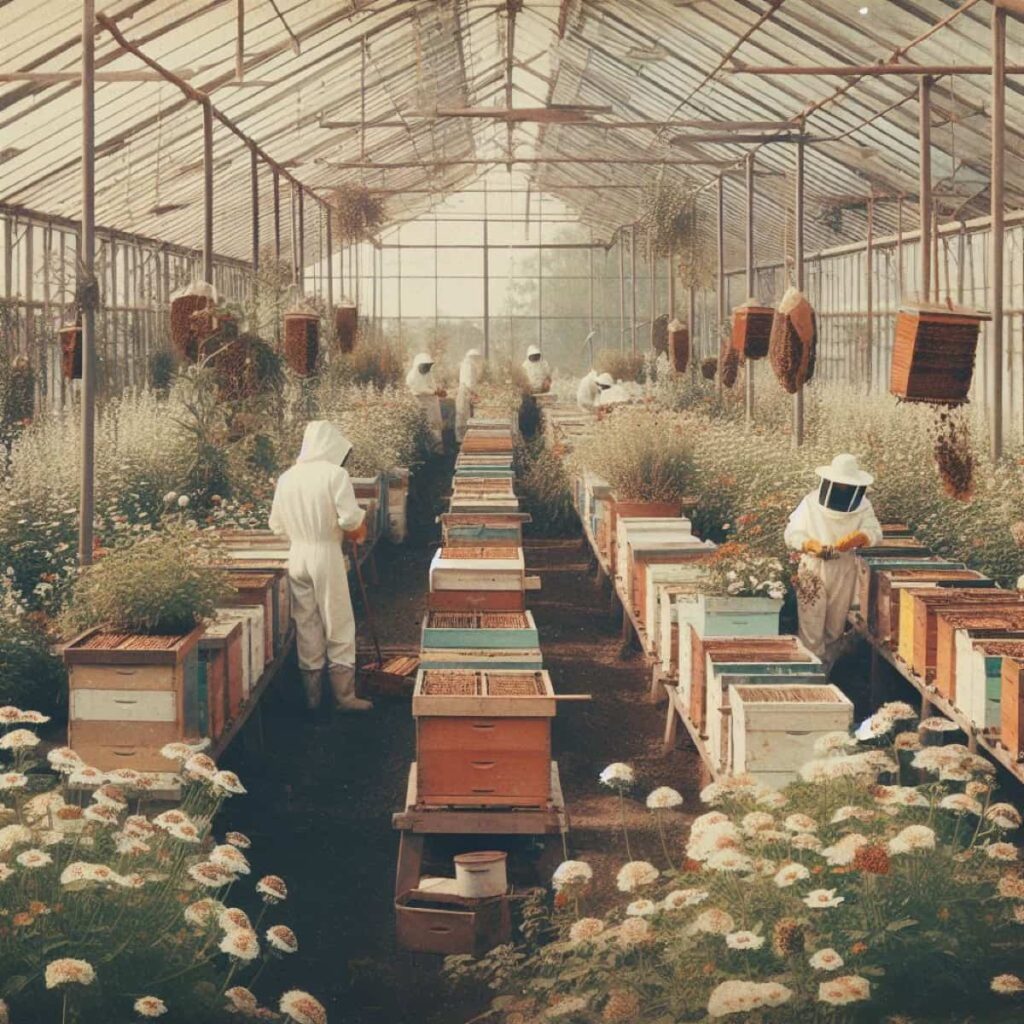
The internal layout should facilitate easy movement for beekeeping activities, such as inspection, feeding, and harvesting. The hives should be placed in a manner that aligns with the bees’ flying paths and natural behaviors, ensuring that they can navigate efficiently within the greenhouse. These design aspects are fundamental in optimizing the greenhouse for successful beekeeping.
Greenhouse Beekeeping Equipment: Essential Tools and Supplies
Regarding greenhouse beekeeping equipment, having essential tools and supplies is crucial for managing and maintaining healthy bee colonies. Basic tools such as hive tools, bee suits, and smokers are fundamental for routine beekeeping tasks. In addition, specific equipment tailored for the greenhouse environment, like temperature and humidity control systems, becomes necessary to monitor and maintain optimal conditions within the greenhouse.
Utilizing a modern method of beekeeping within a greenhouse requires a blend of traditional tools and advanced equipment to ensure that the bees are cared for adequately and that beekeeping activities are conducted efficiently and effectively.
Creating a Healthy Environment for Bees in a Greenhouse
A priority in greenhouse beekeeping is creating a healthy environment where bees can flourish. Essential aspects such as temperature, humidity, ventilation, and access to clean water and forage should be meticulously managed. Ensuring the bees have access to various flora within or near the greenhouse is vital for their nutrition and well-being.
The greenhouse should be kept clean, and measures should be taken to prevent the intrusion of pests and diseases. A holistic approach, focusing on the bees’ overall health and their environment, contributes significantly to the success of greenhouse beekeeping. The nuanced care and attention given to creating a thriving environment within the greenhouse enhance the vitality and productivity of the bee colonies.
Managing Pests and Diseases in Greenhouse Beekeeping
Managing pests and diseases is a crucial aspect of greenhouse beekeeping to ensure the health and productivity of bee colonies. In a controlled environment like a greenhouse, beekeepers have a more hands-on approach to monitoring and controlling pests and diseases. Regular inspection is essential to identify any signs of infestation or illness early, allowing for timely intervention.
In case you missed it: Backyard Beekeeping Cost and Tips for Reducing Backyard Beekeeping Costs
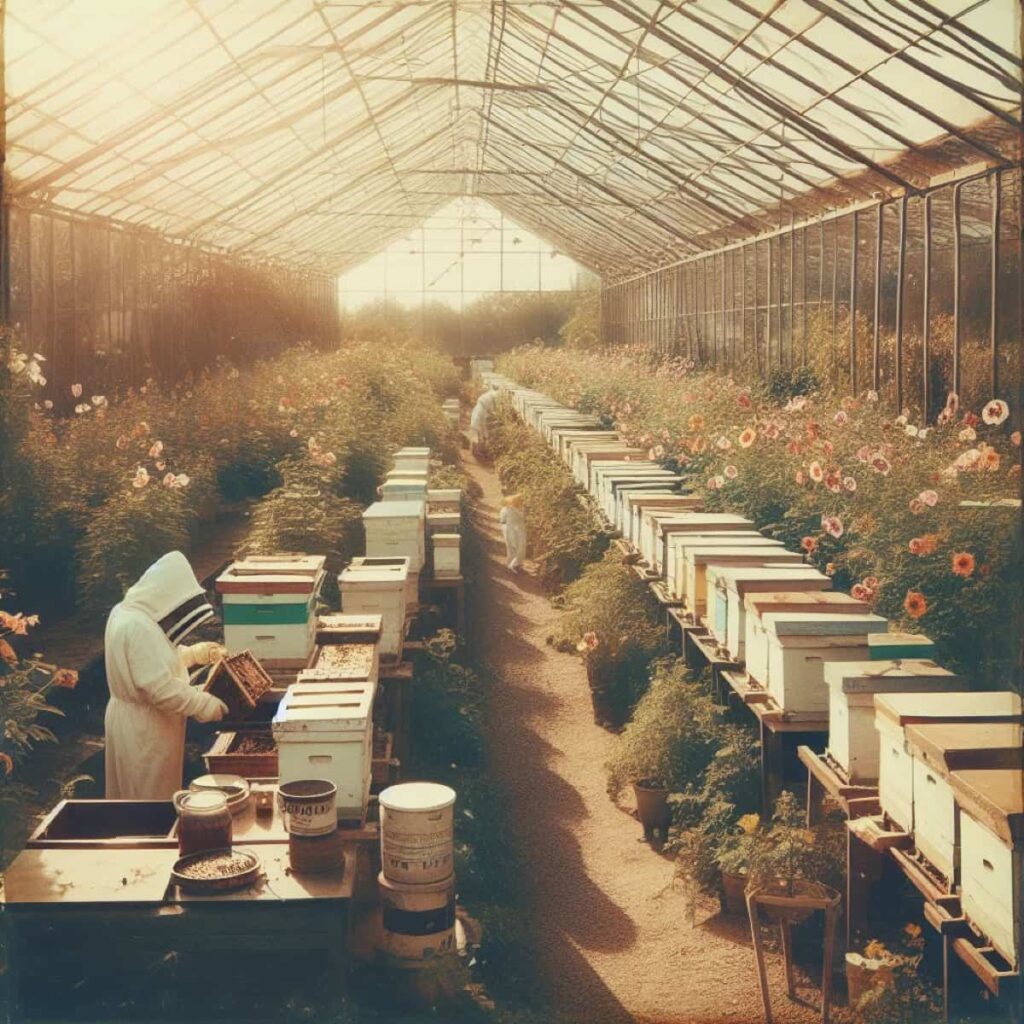
Natural methods such as introducing beneficial insects, using safe pesticides, and maintaining a clean environment can be effective strategies. Ensuring that the greenhouse is well-sealed prevents the entry of pests, and practicing good hygiene and sanitation minimizes the risk of diseases. A robust management plan for pests and diseases is fundamental for sustaining healthy and thriving bee colonies in greenhouse beekeeping.
Optimizing Honey Production in a Greenhouse Setting
Optimizing honey production is one of the primary objectives of greenhouse beekeeping. In a conducive greenhouse environment, bees can work longer seasons, as they are less exposed to harsh weather conditions. Ensuring that the bees have constant access to a diverse range of flowers, either within the greenhouse or externally, is essential for honey production.
Beekeepers can manage and control conditions such as temperature and humidity more effectively, creating an optimal environment for the bees to produce honey. Regular and careful inspection of the hives, proper management of resources, and maintaining the health of the bees are crucial practices that contribute to enhanced honey production in a greenhouse setting.
Greenhouse Beekeeping for Beginners: Getting Started with Success
For beginners diving into greenhouse beekeeping, getting started with success involves a blend of essential knowledge and practical strategies. A foundational understanding of beekeeping principles garnered from reliable sources, such as a training manual, is crucial. Choosing the right greenhouse, designing it effectively for bee colonies, and equipping it with essential tools and supplies are fundamental steps.
Focusing on creating a healthy environment, managing pests and diseases, and optimizing conditions for honey production are vital areas to concentrate on. Beginners should seek to continuously learn, adapt, and apply best practices and modern beekeeping methods to foster success in their greenhouse beekeeping journey.
Advantages and Disadvantages of Greenhouse Beekeeping Compared to Traditional Beekeeping
Greenhouse beekeeping comes with its own set of advantages and disadvantages when compared to traditional beekeeping. The advantages include a controlled environment that protects bees from adverse weather conditions, predators, and various external threats. This controlled setting allows for extended bee activity, enhancing honey production and productivity.
However, the disadvantages entail the costs of setting up and maintaining a greenhouse and the need for continuous monitoring and management of the internal conditions. There might also be limitations regarding foraging opportunities, requiring the beekeeper to provide additional resources to the bees. Weighing these aspects is crucial for beekeepers to make informed decisions in their beekeeping approach.
Greenhouse Beekeeping Techniques for Queen Bee Breeding and Reproduction
Implementing effective greenhouse beekeeping techniques is pivotal for successful queen bee breeding and reproduction. A conducive environment within the greenhouse facilitates the queen bee’s ability to lay eggs and increase the bee colony. Proper hive management, ensuring adequate space, and maintaining optimum temperatures are essential factors that promote successful breeding.
In case you missed it: 11 Best Beekeeping Suits for Men and Women: Prices Included for Beekeepers in the USA
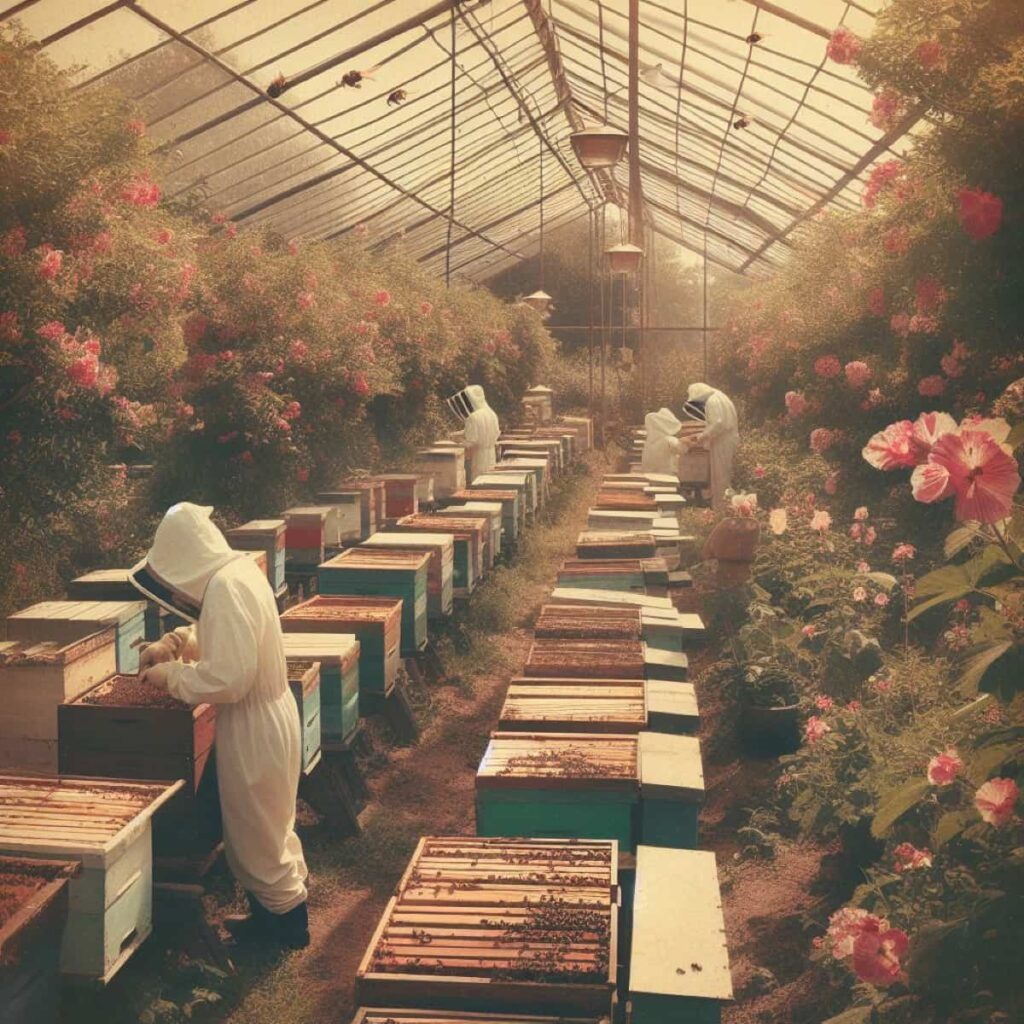
Beekeepers must also ensure the queen bee is healthy, well-nourished, and properly mated. A focus on managing the overall health of the colony, providing necessary resources, and monitoring for any signs of distress or disease is vital for the thriving and reproduction of the queen bee within the greenhouse beekeeping setup.
Greenhouse Beekeeping Regulations and Legal Considerations
Navigating the realm of greenhouse beekeeping also involves adhering to various regulations and legal considerations that govern apiculture practices. Knowledge of and compliance with local, state, and federal laws are crucial. These laws might pertain to the acquisition and management of bee colonies, import and export of bees and bee products, usage of certain equipment and pesticides, and health and safety standards.
It’s also essential to be mindful of zoning laws that might impact where a greenhouse for beekeeping can be located. Regular updates and engagement with local beekeeping associations or regulatory bodies can be beneficial in staying informed and ensuring that the beekeeping activities align with legal requirements and ethical considerations.
Insulating a Greenhouse for Beekeeping: Materials and Methods
Insulation is critical when setting up a greenhouse for beekeeping, as it helps maintain a conducive environment for the bees. Different materials and methods can be used for effective insulation, such as bubble wrap, thermal screens, or reflective materials. These materials help retain heat within the greenhouse during colder seasons, ensuring the bees remain active and healthy.
Additionally, proper insulation contributes to energy efficiency, preventing excessive heat loss and reducing heating costs. The methods applied should align with the greenhouse design, ensuring that there is no compromise on ventilation and natural light, which are essential for the well-being of the bee colonies. Thoughtful planning and execution of insulation strategies are fundamental in optimizing the greenhouse for successful beekeeping.
Greenhouse Beekeeping Automation: Using Technology to Simplify and Improve Beekeeping Practices
Automation and technology have permeated various spheres, including greenhouse beekeeping, offering tools and systems to simplify and improve beekeeping practices. Technologies such as automated ventilation systems, temperature and humidity controllers, and smart hive monitoring systems can be incorporated into the greenhouse.
These technologies facilitate real-time monitoring and management of environmental conditions, ensuring they remain optimal for the bees. Automation also contributes to efficiency, as it can streamline various tasks such as climate control, data collection, and analysis. By leveraging technology and automation, beekeepers can enhance their ability to maintain and manage bee colonies effectively, improving productivity and overall success in greenhouse beekeeping practices.
In case you missed it: 14 Steps to Start Beekeeping in Germany: Types of Bees, Business Plan, License, and Cost
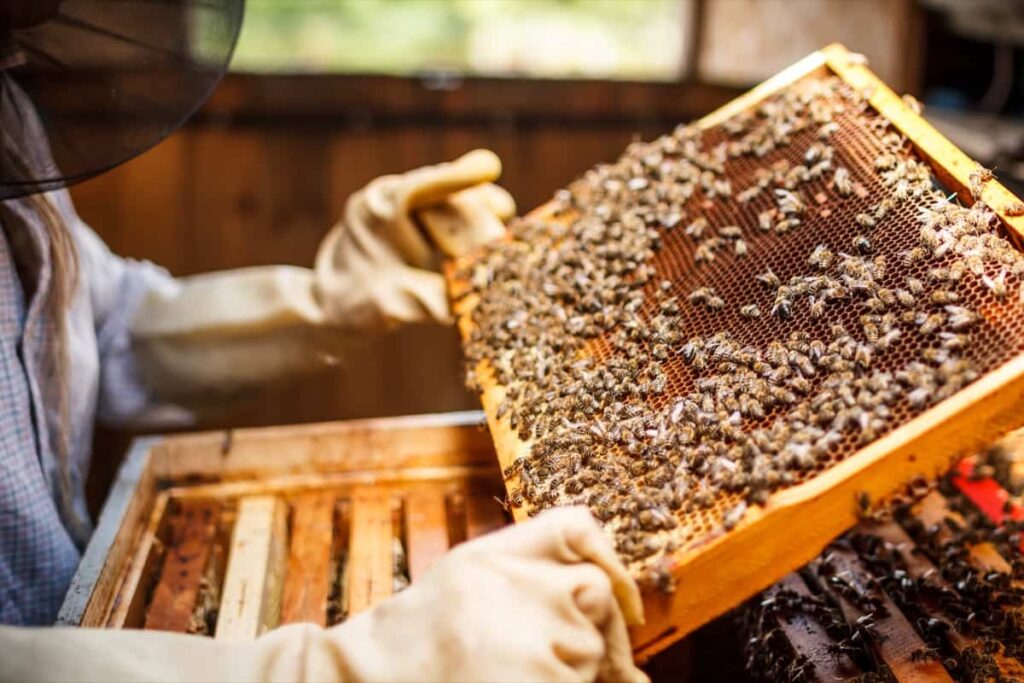
Conclusion
In the tapestry of greenhouse beekeeping, every thread, from design considerations to technological integrations, weaves a canvas of opportunity for enhanced apiculture practices. This guide has journeyed through the pivotal aspects, providing a luminary of knowledge to illuminate the path for aspiring and established beekeepers.
With a foundation cemented in understanding the diverse elements such as equipment, environment management, legal facets, and advanced techniques, greenhouse beekeeping unfolds as a realm of immense potential. In closing, may this compendium serve as a steadfast companion, enriching the greenhouse beekeeping voyage with insights and strategies essential for flourishing in this modernized domain of apiculture.
Frequently Asked Questions (FAQ)
What are the advantages and disadvantages of beekeeping?
Beekeeping offers several advantages, such as producing honey, beeswax, and other bee-related products. It also promotes biodiversity and enhances the pollination of plants, benefiting the ecosystem. However, beekeeping also comes with challenges, such as the risk of bee stings, pests, and diseases affecting the colonies and the necessity for constant management and knowledge updates to maintain healthy bee colonies.
What are the Advantages of Using Beekeeping Methods?
Utilizing proper beekeeping methods optimizes the health and productivity of bee colonies. It ensures effective management of pests and diseases, promotes sustainable practices and enhances the quality of bee products such as honey. Efficient beekeeping methods also facilitate better colony management and organization, improving bee welfare and success in beekeeping endeavors.
What are the Three Important Points Needed for Successful Beekeeping in India?
Successful beekeeping in India necessitates a deep understanding of the local environment and bee species. Ensuring access to diverse flora for the bees’ nutrition is vital. Adequate knowledge and implementation of modern beekeeping techniques and a robust system for managing pests and diseases are also crucial. Lastly, awareness and adherence to regional regulations and best practices in apiculture are essential for sustainable and successful beekeeping.
In case you missed it: Beekeeping Business Plan: Bee Farming Cost, Profit, and Project Report in India
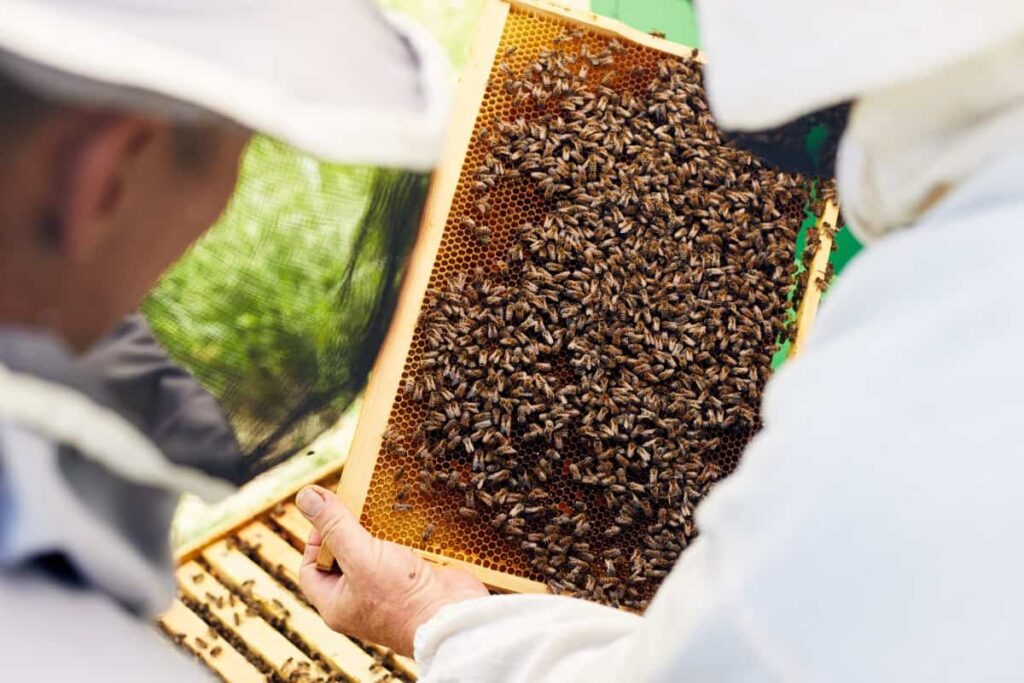
What is the Advantage of Extensive Beekeeping?
Extensive beekeeping allows bee colonies to thrive in a more natural and spacious environment. It encourages biodiversity and enhances the overall health of the bee colonies by providing them with diverse foraging opportunities. This approach also facilitates a more sustainable and ethically responsible form of beekeeping, aligning with conservation and ecological balance principles.
What are the Risks of Honey Production?
Honey production, while rewarding, is laden with several risks. The presence of pests and diseases like mites and foulbrood can compromise the health of the bee colonies and the quality of honey. Bad weather and pesticides can harm honey production, too. Additionally, there’s a risk of contamination if the honey isn’t properly harvested, processed, and stored, which could lead to health concerns for consumers.
What are the Disadvantages of Asexual Reproduction in Honey Bees?
Asexual reproduction in honey bees, or parthenogenesis, has its disadvantages. This causes fewer genes in the bee group, making them get sick more easily and struggle with environmental changes. Without the diversity brought by sexual reproduction, the adaptability and resilience of the colony may be reduced. Additionally, asexual reproduction typically results in a higher proportion of male drones, which do not contribute as much to the hive’s productivity as worker bees do.
- Management Pests and Diseases in Your Cotton Field
- Sheep Farming Business Plan for Beginners
- Aquaponic Farming at Home: A Step-By-Step Guide
- Profitable Village Farming Business Ideas in 2024
- High-Yield Aquaculture: Fast-Growing Fish for Farming
- Effective Fish Pond Construction Techniques for Beginners
- Irrigation and Water Management in Pineapple Farming
- Blossom to Harvest: Mastering Flowering and Pollination in Papaya Farming
- Pig Fattening Essentials: From Selection to Sale for Beginners
- Raising Wagyu Cattle: A Complete Guide for Premium Beef Production
- Soil Types and Their Water Holding Capacity
- Optimizing Irrigation Schedules for Coconut Groves for Enhanced Yield
- Espresso Your Garden: Coffee Grounds for Healthier Acid-Loving Plants
- The Best Soil Mix for Snake Plants: How to Mix Your Own Snake Plant Soil
- Green Thumb Success: Expert Tips for Cultivating Greenhouse Beans All Year Round
- Bloom All Year Round: The Ultimate Guide to Indoor Hyacinth Care
- Eco-Friendly Gardening: How to Make Liquid Fertilizer from Kitchen Waste
- Ultimate Guide to Grow Anise in Pots: Explore Seed Propagation to Harvesting
- Guide to Raising Chester White Pigs: Discover Breed Facts to Growth Management
- Mastering the Elegance: The Ultimate Guide to Weeping Cherry Tree Care, Planting, and Maintenance
- Ultimate Guide to Planting Garlic in Grow Bags: Growing Strategies for Beginners
- How to Fix Spider Plant Leaf-Related Problems: Natural and Organic Remedies
- 10 Reasons Why Your Tulsi Plant is Shedding Leaves: Home Remedies and Solutions
- Optimizing Growth and Yield: The Advantages of Palm Bunch Ash Fertilizer
- Utilizing Neem Oil Extract as a Natural Pesticide for Hydrangea
- From Soil to Harvest: Various Ways in Which Farmers Can Use AI Tools
- Steps to Encourage and Induce Citrus Flowers: A Comprehensive Guide
- How to Fix Snake Plant Leaf-Related Issues: Natural and Organic Remedies
- Transform Your Garden into a Fragrant Oasis with Raat Ki Rani (Night Blooming Jasmine)
- Discover the Ideal Chicken Breeds for Philippine Farms
- How to Create a Poultry Egg Farm Business Plan for Profits
- Grow Lemon Cucumbers Like a Pro: Insider Techniques for Bountiful Yields
- Ultimate Guide to Caring for Your Pink Princess Philodendron: Tips for Thriving Variegation
- Areca Nut Profit Per Acre: Calculating Yield and Cost of Cultivation
- How Kaveri Chicken is Becoming a More Profitable Breed in Indian Backyards
- Transform Your Barn: 9 Steps to Convert a Horse Stall into a Chicken Coop
